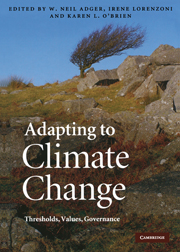Book contents
- Frontmatter
- Contents
- List of contributors
- Preface
- 1 Adaptation now
- Part I Adapting to thresholds in physical and ecological systems
- 2 Ecological limits of adaptation to climate change
- 3 Adapting to the effects of climate change on water supply reliability
- 4 Protecting London from tidal flooding: limits to engineering adaptation
- 5 Climate prediction: a limit to adaptation?
- 6 Learning to crawl: how to use seasonal climate forecasts to build adaptive capacity
- 7 Norse Greenland settlement and limits to adaptation
- 8 Sea ice change in Arctic Canada: are there limits to Inuit adaptation?
- Part II The role of values and culture in adaptation
- Part III Governance, knowledge and technologies for adaptation
- 31 Conclusions: Transforming the world
- Index
- References
8 - Sea ice change in Arctic Canada: are there limits to Inuit adaptation?
Published online by Cambridge University Press: 31 August 2009
- Frontmatter
- Contents
- List of contributors
- Preface
- 1 Adaptation now
- Part I Adapting to thresholds in physical and ecological systems
- 2 Ecological limits of adaptation to climate change
- 3 Adapting to the effects of climate change on water supply reliability
- 4 Protecting London from tidal flooding: limits to engineering adaptation
- 5 Climate prediction: a limit to adaptation?
- 6 Learning to crawl: how to use seasonal climate forecasts to build adaptive capacity
- 7 Norse Greenland settlement and limits to adaptation
- 8 Sea ice change in Arctic Canada: are there limits to Inuit adaptation?
- Part II The role of values and culture in adaptation
- Part III Governance, knowledge and technologies for adaptation
- 31 Conclusions: Transforming the world
- Index
- References
Summary
Introduction
The impacts of climate change have been particularly profound in Arctic regions (ACIA, 2005; IPCC, 2007), with changes in the sea ice standing out (Kerr, 2007). For the Arctic as a whole, ice thickness and extent are decreasing, the ocean is freezing up later in the year and breaking up earlier, and the ice-free open water period is extending (Holland et al., 2006; Overland and Wang, 2007). Similar trends have been documented in the Canadian Arctic (Barber and Hanesiak, 2004; Barber and Iacozza, 2004; Nickels et al., 2006; Furgal and Prowse, 2008; Laidler and Ikummaq, 2008). Anomalous ice conditions are concentrated in recent years of the record, particularly 2002–2007 (Stroeve et al., 2007). Sea ice change is occurring in the context of other changes in the Arctic, and has been attributed to greenhouse gas emissions (IPCC, 2007).
Changing sea ice conditions have already had negative impacts on the livelihoods of the Arctic's Inuit population, many of whom rely on the frozen ocean surface for seasonal transportation between communities and as a platform for culturally important hunting activities (Correll, 2006; Nickels et al., 2006; Ford, 2008a; Ford et al., 2008b). Climate models predict sea ice change to continue into the foreseeable future (IPCC, 2007), with recent research ranking sea ice as the global system at greatest threat to crossing a ‘tipping point’ with climate change (Lenton et al., 2008).
Information
- Type
- Chapter
- Information
- Adapting to Climate ChangeThresholds, Values, Governance, pp. 114 - 128Publisher: Cambridge University PressPrint publication year: 2009
References
Accessibility standard: Unknown
Why this information is here
This section outlines the accessibility features of this content - including support for screen readers, full keyboard navigation and high-contrast display options. This may not be relevant for you.Accessibility Information
- 2
- Cited by
